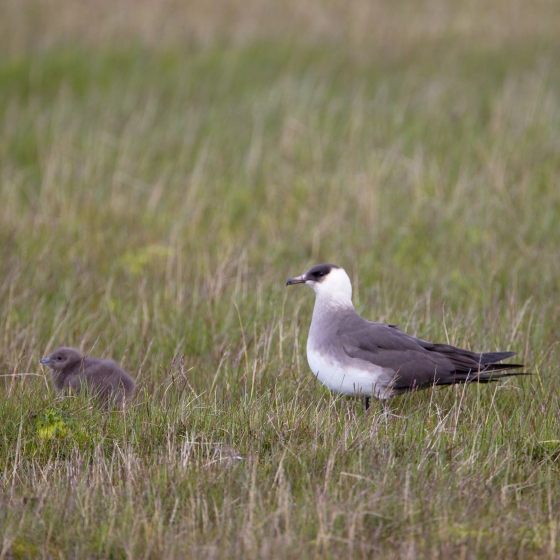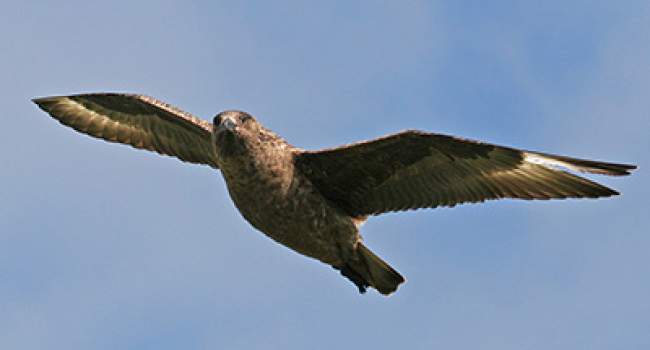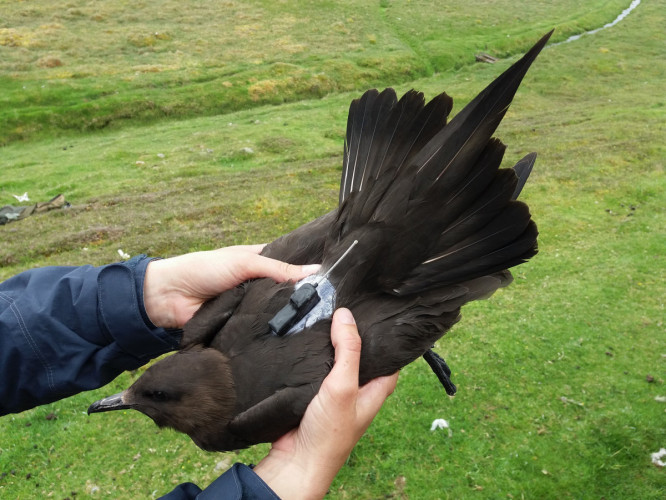Arctic Skua
Stercorarius parasiticus (Linnaeus, 1758)
AC
 ARCSK
ARCSK  5670
5670

Family: Charadriiformes > Stercorariidae

This highly-migratory seabird has a fast and powerful flight that can also be nimble and manoeuvrable. It breeds on moorland in the Arctic but spends most of its year in the open ocean.
A few colonies are found in the far north and west of Britain, on moorland within easy reach of the sea. Elsewhere, Arctic Skuas occur offshore on migration and may be seen close inshore, often when chasing terns.
Seabird censuses reveal that Arctic Skuas breeding in Britain are currently in severe decline. Recent tracking studies have shown that breeding birds make long excursions to gather food for their chicks, perhaps indicating that suitable prey is scarce near the colonies.
Identification
Arctic Skua identification is often difficult. The following article may help when identifying Arctic Skua.
Identifying Skuas

Identifying skuas passing offshore in late summer is one of the great challenges of bird ID. There are clues to help us, however, and - with practice - most individuals can be identified. This workshop will point you in the right direction and help you to focus on the features and markings that will be most helpful when seawatching.
SONGS AND CALLS
Listen to example recordings of the main vocalisations of Arctic Skua, provided by xeno-canto contributors.
Flight call
Call
Develop your bird ID skills with our training courses
Our interactive online courses are a great way to develop your bird identification skills, whether you're new to the hobby or a competent birder looking to hone your abilities.
Browse training coursesStatus and Trends
Population size and trends and patterns of distribution based on BTO surveys and atlases with data collected by BTO volunteers.
CONSERVATION STATUS
This species can be found on the following statutory and conservation listings and schedules.
POPULATION CHANGE
With the UK the Arctic Skua is restricted to north and west Scotland. Based on previous Censuses, the population increased substantially between 1969–70 and 1985–88; despite a subsequent decline, breeding numbers counted by Seabird 2000 (1998–2002) remained approximately double the 1969–70 population. The results of the recent Seabirds Count (2015–2021) are not yet available; however, annual monitoring data suggest that the decline has continued (JNCC 2022). Perkins et al. (2018) found that numbers had declined by 81% between 1992 and 2015 within their core Scottish breeding areas. The effects of the ongoing highly pathogenic avian influenza (HPAI) outbreak are being closely monitored.
DISTRIBUTION
Arctic Skuas breeding in the UK are at the southwestern extremity of their mostly circumpolar breeding range. In the UK they nest in the Northern Isles, Caithness and Sutherland, the Outer Hebrides, St Kilda and a few southern Inner Hebridean islands. Highest numbers are found on Shetland, Orkney and the Outer Hebrides.
Occupied 10-km squares in UK
| No. occupied in breeding season | 119 |
| % occupied in breeding season | 3.9 |
| No. occupied in winter | 108 |
| % occupied in winter | 3.6 |
European Distribution Map
DISTRIBUTION CHANGE
Arctic Skuas have declined significantly and this is beginning to show in the range maps, with losses in the southern part of the range on Islay and Jura.
Change in occupied 10-km squares in the UK
| % change in range in breeding season (1968–72 to 2008–11) | +7.1% |
| % change in range in winter (1981–84 to 2007–11) | +61% |
SEASONALITY
Arctic Skuas are predominantly summer visitors, arriving from April. Peak reporting is during autumn passage in August and September. Occasional birds may winter.

Movement
Information about movement and migration based on online bird portals (e.g. BirdTrack), Ringing schemes and tracking studies.
RINGING RECOVERIES
View a summary of recoveries in the Online Ringing Report.
Foreign locations of birds ringed or recovered in Britain & Ireland

Biology
Lifecycle and body size information about Arctic Skua, including statistics on nesting, eggs and lifespan based on BTO ringing and nest recording data.
SURVIVAL & LONGEVITY
View number ringed each year in the Online Ringing Report
Maximum Age from Ringing 
|
25 years 10 months 24 days (set in 2003) 
|
Typical Lifespan 
|
12 years with breeding typically at 4 year |
Adult Survival 
|
0.886  
|
Juvenile Survival 
|
0.68 (in first year) 
|
BIOMETRICS
Wing Length 
|
Adults | 328.9±8.3 | Range 314–343mm, N=35 |
Body Weight 
|
Adults | 416±37.9 | Range 360–476g, N=36 |
Feather measurements and photos on featherbase 
CODES & CLASSIFICATION
Ring size 
|
E |
Field Codes 
|
2-letter: AC | 5-letter code: ARCSK | Euring: 5670 |
For information in another language (where available) click on a linked name
Research
Interpretation and scientific publications about Arctic Skua from BTO scientists.
CAUSES AND SOLUTIONS
Causes of change
The decline in the Arctic Skua population is believed to be driven by strong decreases in breeding productivity (Perkins et al. 2018), with complete breeding failure occurring more frequently (JNCC 2022). Arctic Skuas are kleptoparasites, stealing food from other seabirds such as Kittwakes and auks. Recent declines for these species have been linked to the decline in their prey species, in particular sandeels Ammodytes marinus and it is likely that this will also have affected Arctic Skua productivity (Dwason et al. 2011; Perkins et al. 2018). Productivity is also likely to have been impacted by increases in the Great Skua population, through increased predation of Arctic Skua chicks (Meek et al. 2011; Perkins et al. 2018) and also through competition for territories (Dawson et al. 2011) and food (Meek et al. 2011).
PUBLICATIONS (1)

New insights into the migration and wintering areas of Scottish-breeding Arctic Skuas
Arctic Skuas breed in dwindling numbers on Scotland’s northern coasts and islands.
Links to more studies from ConservationEvidence.com
Would you like to search for another species?












Share this page